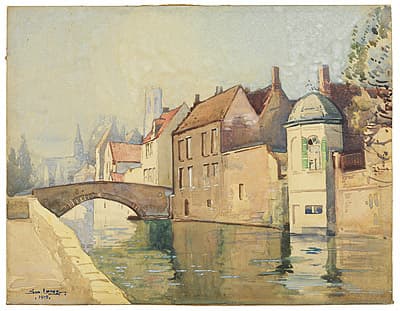
Sydney
LONG
Australia
1871
–
London
1955
England, Europe 1910-21; Australia 1921- 22; England 1922-25; Australia 1925-52; England from 1952
23.6 (h) x 30.5 (w) cm
signed and dated ‘SID LONG/ 1913’ lower left Queensland Art Gallery, Brisbane, bequest of George Brown 1977
Canal scene, Bruges is a view of the Groenerei Canal, in the medieval town of Bruges, the capital and largest city of West Flanders in north-west Belgium. Along with other canal-based northern cities, such as Amsterdam, Bruges is sometimes referred to as ‘the Venice of the north’. It is a strangely anachronistic city, with its looping dead-end canals and winding, narrow, cobbled streets.
In August 1913 Long visited Bruges and was impressed by the city. His art flourished under the stimulus of the new environment, and he responded to the light and the landscape there because it was ‘brighter and more cheerful than the English landscape. Not so pretty and generally more interesting’. He wrote: ‘I think they [oil sketches] are very interesting and full of colours, so I hope you will do well with them’; and later ‘I liked Bruges very much ... The place was packed with tourists simply swarming with English people whose stodgy appearance absolutely killed the surroundings. I got a lot of … very interesting stuff’ (Long, 2 September 1913).
In this watercolour Long depicted the town as a silent city, with windows closed and the still water in the canal mirrored with reflections, a slight deformation of the everyday world.
Many Symbolists were interested in Bruges and came to visit this fascinating city. Dante Gabriel Rossetti wrote a number of poems there, Ford Maddox Brown, William Morris and William Holman Hunt also visited, and Stéphane Mallarmé lectured there.
Canal scene, Bruges is a view of the Groenerei Canal, in the medieval town of Bruges, the capital and largest city of West Flanders in north-west Belgium. Along with other canal-based northern cities, such as Amsterdam, Bruges is sometimes referred to as ‘the Venice of the north’. It is a strangely anachronistic city, with its looping dead-end canals and winding, narrow, cobbled streets.
In August 1913 Long visited Bruges and was impressed by the city. His art flourished under the stimulus of the new environment, and he responded to the light and the landscape there because it was ‘brighter and more cheerful than the English landscape. Not so pretty and generally more interesting’. He wrote: ‘I think they [oil sketches] are very interesting and full of colours, so I hope you will do well with them’; and later ‘I liked Bruges very much ... The place was packed with tourists simply swarming with English people whose stodgy appearance absolutely killed the surroundings. I got a lot of … very interesting stuff’ (Long, 2 September 1913).
In this watercolour Long depicted the town as a silent city, with windows closed and the still water in the canal mirrored with reflections, a slight deformation of the everyday world.
Many Symbolists were interested in Bruges and came to visit this fascinating city. Dante Gabriel Rossetti wrote a number of poems there, Ford Maddox Brown, William Morris and William Holman Hunt also visited, and Stéphane Mallarmé lectured there.
Canal scene, Bruges is a view of the Groenerei Canal, in the medieval town of Bruges, the capital and largest city of West Flanders in north-west Belgium. Along with other canal-based northern cities, such as Amsterdam, Bruges is sometimes referred to as ‘the Venice of the north’. It is a strangely anachronistic city, with its looping dead-end canals and winding, narrow, cobbled streets.
In August 1913 Long visited Bruges and was impressed by the city. His art flourished under the stimulus of the new environment, and he responded to the light and the landscape there because it was ‘brighter and more cheerful than the English landscape. Not so pretty and generally more interesting’. He wrote: ‘I think they [oil sketches] are very interesting and full of colours, so I hope you will do well with them’; and later ‘I liked Bruges very much ... The place was packed with tourists simply swarming with English people whose stodgy appearance absolutely killed the surroundings. I got a lot of … very interesting stuff’ (Long, 2 September 1913).
In this watercolour Long depicted the town as a silent city, with windows closed and the still water in the canal mirrored with reflections, a slight deformation of the everyday world.
Many Symbolists were interested in Bruges and came to visit this fascinating city. Dante Gabriel Rossetti wrote a number of poems there, Ford Maddox Brown, William Morris and William Holman Hunt also visited, and Stéphane Mallarmé lectured there.
